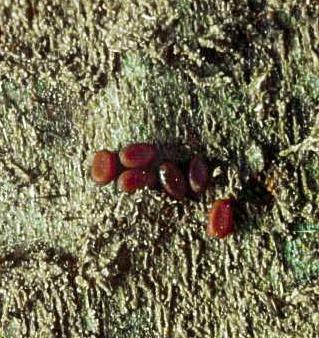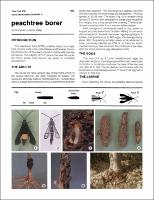peach tree borer life cycle
The peach tree borer is a serious pest only to young trees. This borer overwinters in a wide range of larval stages.

Lesser Peachtree Borer Nc State Extension Publications
Adult moths of the lesser peachtree borer emerge from late May through September while peachtree borers emerge from midJune to early September.

. In the spring the larva will construct a silken cocoon and cover it with tiny bits of chewed wood. Larvae tunnel primarily into the lower trunk and roots feeding on growing tissue and inner bark. Egg laying begins soon after emergence and mating and larvae tunnel into the bark to feed until the.
The peach tree borer completes one life cycle a year. When full grown the larva is 1-14 in long cream colored with a dark brown head. Damage Any wound on stone fruit trees may cause gum to exude.
Adults begin emerging in late spring and early summer from larvae that have overwintered inside the tree an inch or two beneath the soil line. Because the egg laying period is so long overwintering larvae vary greatly in size. The winter is spent as a larva under the bark.
Life cycles of peachtree borers and lesser peachtree borers. The egg stage lasts about 12 days. The period of time required to complete a life cycle varies considerably throughout the range of the peachtree borer.
The larval stage of PTB is an indirect pest of stone fruit trees. It is reported that it takes two years to complete a life cycle in Canada and in a small percentage of populations in New York. Produced by peachtree borer.
Much of the United States including Texas and Nebraska has one generation per year. In the spring feeding is resumed and the larval period is completed. Life Cycle and Damage Peach tree borers overwinter as partially grown larvae in a gallery under the bark.
Hatching larvae tunnel into the tree at or slightly below ground level. Borer damage is usually attended by gumming with varying amounts of frass in the gum. Only the immature larva stage Figure 3 produces the damage to trees.
They continue to emerge throughout the. Female moths lay their eggs during the summer on bark at the base of tree trunks. In the spring feeding is resumed and the larval period is completed.
Eggs are laid on the tree trunk or on nearby foliage. Winter is spent as a larva under the bark in the cambium layer. Adult peachtree borers emerge in the late spring or early summer.
The adult peachtree borer is a steel blue to black moth that resembles a wasp. Life Cycle The period of time required to complete a life cycle varies considerably throughout the range of the peachtree borer. This is in contrast to lesser peachtree borer which may feed on any part of the tree Root feeding leads to reduced crop bearing capacity due to lack of nutrient uptake while heavy trunk feeding can.
Usually they are close to or below ground level. Peach tree borers overwinter as partially grown larvae in a gallery under the bark. The borer will remain in the pupal stage from 18 to 30 days before emerging as an adult.
Because the egg laying period is so long overwintering larvae vary greatly in size. The pests life cycle and treatment is similar to those of exitiosa. Adult peach tree borers are moths with clear wings frequently mistaken for wasps.
The peachtree borer overwinters as a partly grown larva in its burrow beneath the bark of the tree. Life Cycle and Damage. The presence of small particles of wood and bark within the gum distinguish damage by peachtree borer Life History and Habits The life cycle of the peachtree borer requires one year to complete.
The lesser borer completes about one and one-half cycles a year. The clear-winged female moths lay their eggs on the bark at the base of tree trunks in mid- to late-summer. Peachtree borer has a single generation per year but it can result in severe losses if not managed correctly.
Moths emerge from mid-July to September and egg laying begins soon after emergence. In the spring feeding is resumed and the larval period is completed. The adult borer emerges in the late spring and early summer.
It is reported that it takes two years to complete a life cycle in Canada and in a small percentage of populations in New York. Larvae become active and resume feeding in April with larger larvae. Usually they are close to or below ground level.
When mature the larva constructs a cocoon under the bark at or near soil level and pupates. The peachtree borer overwinters as a partly grown larva in its burrow beneath the bark of the tree. Seasonal development and life cyclePeachtree borer.
Hatching larvae tunnel into the tree at or slightly below ground level. As temperatures warm up they resume boring and usually complete their feeding in May. Trees protected from peach tree borer the first 4 to 5 years do not usually suffer serious injury.
Female borers lay their eggs at the base of the trees trunk in the spring placing the eggs. Upon hatching from the eggs Figure 4.

Lords Environmental Peach Tree Borers

Lesser Peachtree Borer Damage Stock Image C025 7085 Science Photo Library
Pests Bc Tree Fruit Production Guide

Peachtree Borer 5 566 Extension

Peach Tree Borer Fairfax Gardening

Goes To Show You Don T Ever Know Plant Pest Advisory

Peach Tree Borers How To Control Peach Tree Borers

Peachtree Borer Nc State Extension Publications

Peach Tree Borer Treatment Control Planet Natural

Greater Peachtree Borer In The Landscape Nc State Extension Publications
Pests Bc Tree Fruit Production Guide

Peach Tree Borer Trap Pest Control From Gardens Alive
Peachtree Borer Wsu Tree Fruit Washington State University
Eny 691 In489 Peachtree Borers In The Home And Commercial Peach Orchard


